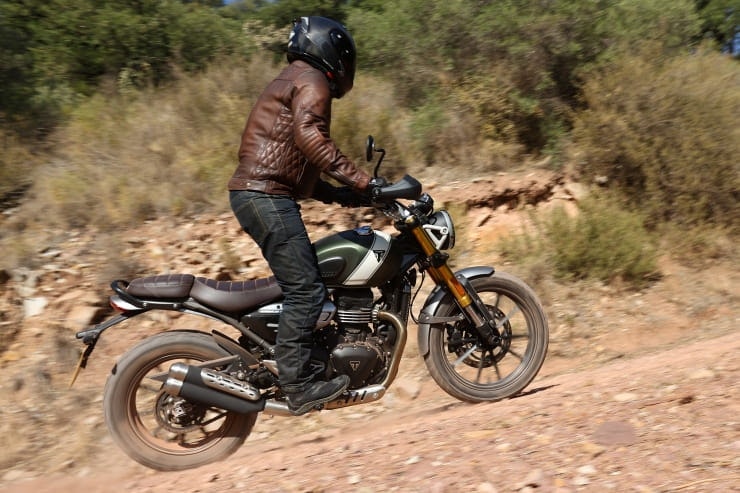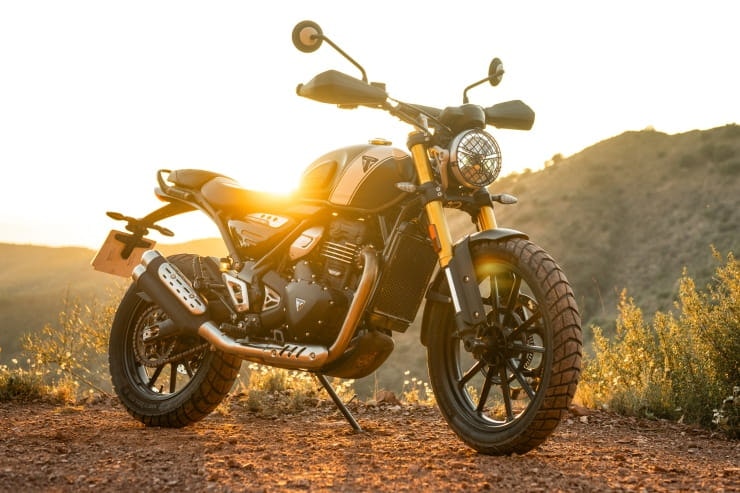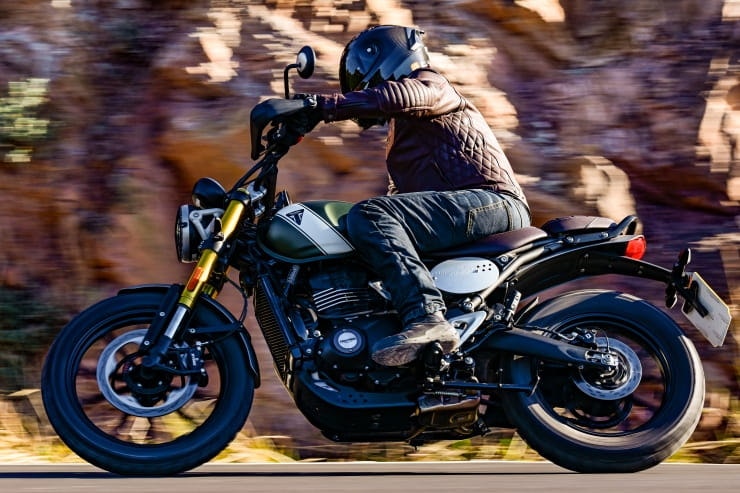Technical Review: Ben Purvis
Press launch review: Martin Fitz-Gibbons
Price: £5595 | Power: 39.5bhp | Weight: 179kg | Overall BikeSocial Rating: 4/5
Triumph’s Scrambler line-up is an enduring success for the British brand so it’s no surprise that a miniature version is among the launch line-up for its new 400cc single-cylinder model range. Diving headfirst into a class of bikes as varied as Royal Enfield’s Scram 411, KTM’s 390 Adventure and Honda’s CL500, the new Triumph Scrambler 400 X is immediately competitive.
Sitting on an all-new platform developed in partnership with India’s Bajaj, the first fruit of a long-standing relationship between the companies, the Scrambler 400 X shares a few core parts with the new Street 400 roadster. Other than engine, subframe and swingarm, pretty much everything else – frame, suspension, wheels, brakes, tyres, handlebars, pegs, seats and so on – are unique to the Scrambler.
Despite being a result of Triumph’s Bajaj partnership, the Scrambler 400 X will be built in Triumph’s factories in Thailand and Brazil as well as Bajaj’s Indian plants.
Gorgeous looks and incredible detailing
More power than most rivals
Deceptively full-size riding position
No wire wheel option
Off-road ability not quite up with small-cc adventurers
Slower on-road steering than Speed 400
2024 Triumph Speed 400 and Scrambler 400X Review
For 2024 Triumph has developed and built in cooperation with India’s Bajaj not one but two new motorcycle using an entirely new platform built around a 398cc, single-cylinder engine - the Speed 400 and Scrambler 400X. Our man, Martin Fitz-Gibbons has been to ride both of them back-to-back for your delectation.
The Geek Test: Triumph Scrambler 400 X
Welcome to the Geek Test, where road test hero and long-time BikeSocial contributor, Simon Hargreaves, gets properly nerdy by measuring size, weight and performance of the Triumph Scrambler 400 X
2024 Triumph Scrambler 400X price
The launch price of a Scrambler 400 X is a very reasonable £5595. That’s £600 more than its Speed sibling, for which you get a number of extra parts including handguards, headlight grille and a radiator guard, not to mention different wheels, suspension, bars, pegs and even frame.
That price slots it in neatly among its contemporaries. It’s more than a Royal Enfield Scram 411 (£4849), but packs almost twice the power and a much more modern tech level. At the other end of things it’s a substantial saving over KTM’s 390 Adventure (£6599), and even cheaper than BMW’s G310GS (£5890). On paper, its closest rival on price might well be Husqvarna’s Svartpilen 401 (£5599).
The Scrambler is offered in three colour options: Phantom Black with a Silver Ice stripe on the tank, Matt Khaki Green with a Fusion White stripe, or Carnival Red with a Phantom Black stripe. Thankfully, all three are the same price – there’s no “premium paint” option going on here.
If you’re looking at buying a Scrambler on PCP, a £999 deposit leaves three years of £75.25 monthly payments – roughly £7 a month more than the Speed.
2024 Triumph Scrambler 400X Engine & Performance
The 398cc, DOHC, liquid-cooled single-cylinder engine is exactly the same one featured in the new Speed 400, with no change to its peak of 40PS (39.5hp) at 8000rpm or its 37.5Nm (27.7lb-ft) of torque at 6500rpm. The Scrambler 400 X does feature a different twin-exit exhaust end can, but the change is purely for looks and doesn’t affect performance.
There are no changes to internal gear ratios either. The Scrambler uses a smaller front sprocket (14 tooth instead of the Speed’s 15-tooth part), but this is purely to compensate for the Scrambler’s different rear wheel circumference – meaning overall gearing is virtually identical.
Unsurprisingly, the engine behaves identically to the Speed. It’s an undemanding engine – neither a bottom-end thumper nor a top-end screamer. It’s linear and easy in the lower half of the revs, hits its perky spot from 6000 to 8000rpm, then holds flat power to the 9500rpm limiter. The exhaust note is pleasing yet polite, while a counter-rotating balance shaft does a very effective job of removing unwanted lumpy vibrations.
It is, however, quite a busy engine thanks to the short overall gearing. In top gear 70mph requires 7000rpm, and while mirrors stay smooth and no nasty lumpiness gets through pegs or bars, you’re also constantly aware the motor is thrumming away at high speed. If you weren’t paying close attention to the gear position indicator on the dash, you’d often be tempted to go for a non-existent seventh gear.
The short gearing also means first gear is dispatched unexpectedly quickly. In turn, it might also be responsible for a slight over-eagerness sub-10mph in first when winding the throttle open from completely shut. It’s a tiny thing though – this is not in any way a snatchy engine.
There’s a full ride-by-wire throttle, but no riding modes to choose from. Traction control is standard but can be disabled at a standstill with just a few button pushes. Handy for when you want to head off-road…
2024 Triumph Scrambler 400X Handling, weight and suspension
The Scrambler’s frame uses the same tubular steel ‘hybrid’ design as the Speed 400, but unexpectedly it’s actually a different item, with a 20mm extension near the steering head. This lengthens the Scrambler’s wheelbase, adding stability, as does using a 2-link-longer chain and pushing the rear wheel further back in the chain adjusters.
Suspension is longer at both ends than the Speed too, with 150mm travel – a small increase, but still a long way off small-cc adventurers like the Royal Enfield Himalayan or Honda CRF300 Rally. Wheel and tyre sizes are different, with a larger 19-inch front wheel and narrower rubber at both ends. The tyres themselves are different too: still Metzeler, but Karoo Streets (a slightly treaded adventure-style tyre) replacing the Speed’s sporty M9RR.
The end result of all these differences – longer wheelbase, larger front wheel, higher centre of gravity, plus carrying 9kg more kit than the Speed – is that the Scrambler feels slightly slower to turn, so it rides best with a more measured, mature mindset. Where the Speed can be snapped into corners fast and keen, the Scrambler is (relatively) more of a steady, bend-swinging kind of bike.
Suspension quality, like the Speed, is phenomenal for the price. Unlike some other ‘affordable’ bikes there’s no sign of unpleasant or unwanted plunging through soft, long-travel springs every time you hit the brakes, no hint of woeful underdamping when you ride over a speed bump. Good thing too, as there’s no damping adjustment at either end, and only a small stepped preload adjuster on the shock.
2024 Triumph Scrambler 400X Comfort & Economy
At 835mm, the Scrambler’s seat is substantially taller than the Speed 400’s 790mm. At 5ft 9in I can only just about flat-foot both sides together, so even though it’s ‘just’ a 400, the proportions aren’t far off those of a full-size bike.
The riding position is very different to the Speed too. Higher, wider steel bars (complete with brace and Triumph-branded foam pad) replace the Speed’s tapered aluminium handlebar. Steel footpegs with removable rubber inserts are set slightly lower, for more legroom. On the road this all comes together to give a larger, more commanding riding position, but one that feels fractionally more distant to the front end of the bike. For long days and distance, it’s the Scrambler. For B-road antics, it’s the Speed.
Off-road, the Scrambler’s standing-up ergonomics don’t feel quite as natural or intuitive as I perhaps expected. The bars set hands a little too low, while the Scrambler’s chassis doesn’t flood a rider with dirt confidence, feeling a little nervous and squirrelly along the dry, dusty trail photo location Triumph used at the world launch. In competent hands it can clearly boogie, but sadly it isn’t an adventure bike in retro clothes.
Triumph say the Scrambler is good for 80.7mpg which, if accurate, gives the potential for a 230-mile range from the 13-litre fuel tank. Unfortunately we didn’t get a chance to independently check the real world economy at the launch.
2024 Triumph Scrambler 400X brakes
The Scrambler 400 X uses a 320mm front disc, 20mm larger than the Speed’s – Triumph say this isn’t about giving extra power as such, but simply to match the Scrambler’s larger front wheel. The four-piston, radially mounted ByBre caliper is unchanged, though the brake pad compound is different from the Speed, giving a more gentle bite better suited for off-road use. You can tell the difference – there’s good power and feel, but it’s a less aggressive setup and can require a slightly firmer pull on the non-adjustable lever.
The rear brake is identical: a single piston floating caliper on a 230mm disc, just like the Speed 400, while braided lines remain standard. ABS, however, can be completely disabled on the Scrambler for off-road use – this isn’t an option on the Speed.
2024 TRIUMPH SCRAMBLER 400X Rivals
Royal Enfield Scram 411 | Price: £4599
At first glance one might hope that the Scrambler 400 X would be a natural competitor for Royal Enfield’s Himalayan 452. Having ridden it, it’s probably closer in spirit to the Indian firm’s lower, less-off-roady Scram 411. The Scram is, however, a far less modern option, considerably down on power, tech and chassis spec, but it’s also £750 cheaper.
Power/Torque: 24bhp/23.6lb-ft | Weight: 185kg (kerb)
KTM 390 Adventure | Price: £6299
Another bike built, like the Triumph, with the aid of Bajaj, the KTM 390 Adventure offers a fraction more power than the Scrambler 400 X. It’s slightly more off-road-focused, with wire wheels available as an option. Its stylish sibling, Husqvarna’s Svartpilen 401, could also be considered a rival, though its 17in front wheel may hamper it off-road.
Power/Torque: 43bhp/27.3lb-ft | Weight: 161kg (dry)
Honda CL500 | Price: £6149
A slightly left-field choice, but as an A2-compliant urban runaround with scrambler styling it’s actually fairly close on paper. The Honda has more power, more torque, the same 150mm fork travel and a 19in front wheel – though it’s a chunk heavier too. It’s also only £550 more expensive, which some folk might think isn’t much to pay for an entire extra cylinder…
Power/Torque: 46bhp/32lb-ft | Weight: 191kg (kerb)
2024 Triumph Scrambler 400X Verdict
Along with the Speed 400, the Scrambler 400 X is an amazingly impressive creation given they’re Triumph’s smallest ever road bikes. The sense of quality is something special for this price point, the details incredibly well considered, and the dynamic as easy or as exciting as you want to make it. Whether you’re an A2-licence-clutching newbie or a grizzled old goat, you’ll be deeply impressed.
What the Scrambler offers over the Speed comes down to three areas: a larger, more spacious riding position; a tougher, more rugged image; and the ability to occasionally trundle off down an easy trail. It isn’t, however, a dedicated dirt bike, nor does the classic aesthetic hide modern adventure-bike ability. Perhaps further down the line there’s a Tiger 400 with a 21-inch front, 200mm suspension travel and wire wheels – who knows. Manage your off-road expectations for the Scrambler and you’ll get along great.
The trade-off for the Scrambler’s larger front wheel, longer chassis and extra weight is a slightly less involving ride on B-roads. Where the Speed darts into turns giddily, the Scrambler rolls in to them more sensibly. Then again, its more comfortable, more laid-back nature may well be exactly what you’re after. If it sounds like the kind of thing you’re after, then you should absolutely book a test ride today – the Scrambler 400 X really is that good.
If you’d like to chat about this article or anything else biking related, join us and thousands of other riders at the Bennetts BikeSocial Facebook page.
2024 Triumph Scrambler 400X - Technical Specification
Looking for motorcycle insurance? Get a quote for this motorbike with Bennetts bike insurance
What is MCIA Secured?
MCIA Secured gives bike buyers the chance to see just how much work a manufacturer has put into making their new investment as resistant to theft as possible.
As we all know, the more security you use, the less chance there is of your bike being stolen. In fact, based on research by Bennetts, using a disc lock makes your machine three times less likely to be stolen, while heavy duty kit can make it less likely to be stolen than a car. For reviews of the best security products, click here.
MCIA Secured gives motorcycles a rating out of five stars (three stars for bikes of 125cc or less), based on the following being fitted to a new bike as standard:
A steering lock that meets the UNECE 62 standard
An ignition immobiliser system
A vehicle marking system
An alarm system
A vehicle tracking system with subscription
The higher the star rating, the better the security, so always ask your dealer what rating your bike has and compare it to other machines on your shortlist.


